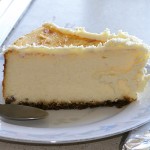Have your cake and eat it – Shavu’ot
 Jewish cuisine is as varied as the Jewish people. There are Jews who come from all over the world, and there are Jewish food customs that reflect all the environments in which Jews have lived.
Jewish cuisine is as varied as the Jewish people. There are Jews who come from all over the world, and there are Jewish food customs that reflect all the environments in which Jews have lived.
But on some foods all Jews are united – not gefilte fish or chopped liver, but the eating of dairy foods on Shavu’ot.
As this is the festival of Torah, dairy foods are seen as a symbol of Torah.
As milk is the basic nourishment for the human being, so is Torah the basic nourishment for the soul. As milk is free of charge for the baby, so is Torah easily accessible to the Jew.
The sources quote Biblical verses to prove these points, and they offer additional theories too: for example, as milk becomes sour if kept in gold containers, so the Torah cannot cope with know-alls who have an over-high opinion of themselves.
So these and other explanations ensure that your Shavu’ot cheese cake will not only be tasty but reflect important ideas in Judaism.
Many communities had in addition their own types of Shavu’ot cake.
In North Africa a cake known as Seven Heavens used to be baked for this festival. It was made up of seven circles, on top of each other, each one smaller than the one beneath it. The circles stand for the seven heavens through which Moses had to pass in order to receive the Torah.
The cake was ornately decorated. There was a ladder for Moses to climb; his staff; a model of Mount Sinai; the Ark of the tablets of the Decalogue, and the tablets themselves; and the quail which the Israelites ate in the wilderness.
All this illustrates the importance of symbolism in Judaism. Our heritage never remained mere theology or theory. Great ideas were expressed in often homely symbols. Freedom, for instance, meant so much more to even the least intellectual Jew because of the matzot and the sweet and sour foods eaten on Pesach.
God’s bounty was so much more real and obvious because of the four plants that figure on Sukkot. Alertness to the call of conscience and duty was far more effective because of the shofar on Rosh HaShanah. This was the genius of Judaism, that it garbed its ideas and ideals in symbols that spoke to every Jew.
But there is a paradox when it comes to Shavu’ot. Yes, cheesecake and dairy foods, Seven Heavens and other cakes, all figure on the festival menu. But there are no specific mitzvot without which it would not be Shavu’ot.
The intrinsic connection between matzah and the Pesach story is obvious, as is the inherent link between the sukkah and the institution of Sukkot. But Shavu’ot is the poor relation, the Cinderella of the calendar.
Indeed the fact that it is the least observed yom-tov of all is probably because it lacks dramatic celebrations: really all it has is the reading of the Ten Commandments.
The reason is that all the other festivals celebrate a part of Judaism, whilst Shavu’ot celebrates Judaism as a whole – not part of the Torah, but the Torah in its entirety.
So how should a Jew celebrate the whole Torah?
Not by a symbol, but by a commitment – a commitment to Torah study on whatever level and in whatever way fits one’s own disposition, mind and temperament.
Not that anyone will or needs to become a rabbi overnight if at all. The Talmud is very wise when it says that on arrival at the entrance to Gan Eden, a person is not asked, “Were you a scholar?” but rather, “Did you set aside time for Torah?” (Shabbat 31a). We have time for TV, time for everything – but to be a worthwhile Jew, we need time for Torah as well.
Nothing is more exciting, exhilarating and satisfying than finding meaning in one’s life and one’s Judaism by means of Torah.



